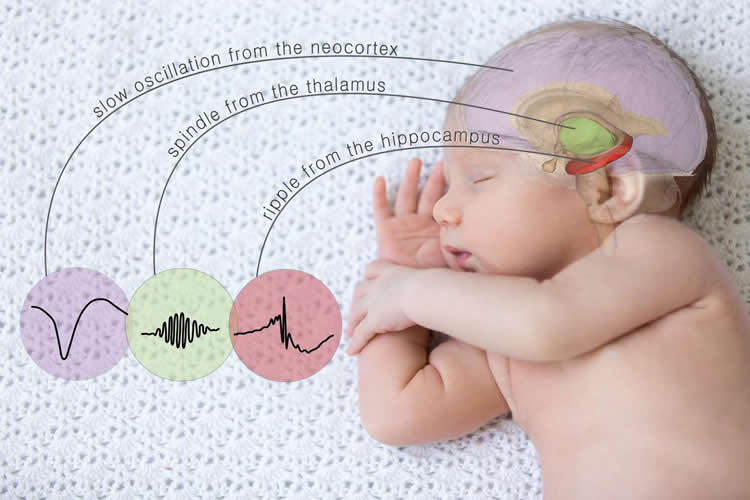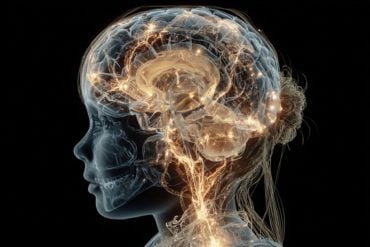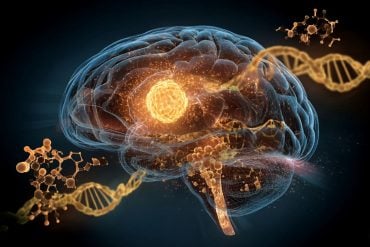Summary: Using optogenetics, researchers manipulated pulses of neural activity during non REM sleep that made mice either remember of forget things they had learned. This novel study demonstrated that altering sleep spindle oscillations during sleep has an impact on memory formation and retention.
Source: Institute For Basic Science.
IBS researchers find that manipulating the pulses of electrical activity in the thalamus during non-REM deep sleep make mice remember or forget.
Have you ever tried to recall something just before going to sleep and then wake up with the memory fresh in your mind? While we absorb so much information during the day consciously or unconsciously, it is during shut eye that a lot of facts are dispatched to be filed away or fall into oblivion. A good quality sleep is the best way to feel mentally refreshed and memorize new information, but how is the brain working while we sleep? Could we improve such process to remember more, or maybe even use it to forget unwanted memories?
Scientists at the Center for Cognition and Sociality, within the Institute for Basic Science (IBS), enhanced or reduced mouse memorization skills by modulating specific synchronized brain waves during deep sleep. This is the first study to show that manipulating sleep spindle oscillations at the right timing affects memory. The full description of the mouse experiments, conducted in collaboration with the University of Tüebingen, is published in the journal Neuron.
The research team concentrated on a non-REM deep sleep phase that generally happens throughout the night, in alternation with the REM phase. It is called slow-wave sleep and it seems to be involved with memory formation, rather than dreaming.
During slow-wave sleep, groups of neurons firing at the same time generate brain waves with triple rhythms: slow oscillations, spindles, and ripples. Slow oscillations originate from neurons in the cerebral cortex. Spindles come from a structure of the brain called thalamic reticular nucleus and spike around 7-15 per second. Finally, ripples are sharp and quick bursts of electrical energy, produced within the hippocampus, a brain component with an important role in spatial memory.
“Often during the night a regular pattern is manifested, where a slow oscillation from the cortex is immediately followed by a thalamic spindle and while this happens, a hippocampal ripple appears in parallel. We believe that the correct timing of these three rhythms acts like a communication channel between different parts of the brains that facilitates memory consolidation,” explains Charles-Francois V. Latchoumane, first co-author of the study.
The researchers focused on spindles because it was shown that the number of spindles is connected with memorization. It has been shown that the number of spindles increases following a day stuffed with learning and declines in the elderly, and in patients with schizophrenia. This is the first study to show that artificial thalamic spindles affect memory, if administered in sync with slow oscillations.
In the experiment, mice were put in a special cage and given a mild electric shock after hearing a tonal noise. The day after, their memory was tested, by checking their fear reaction in response to either the same noise or the same cage. Latchoumane explains that this could be simplified and compared to the experience of hearing a fire alarm in a certain location, like a cafe. The incident would be followed by either another visit to the same cafe or the sound of the fire alarm in another cafe on the following day.
At nighttime between the two days, scientists introduced artificial thalamic spindles in some of the mice using a light-based technique called optogenetics. The mice were divided into three groups. The first group received the light input just after the slow oscillations, so their spindle could form a triple rhythm (in phase): slow oscillation-spindle-ripples. In the second group the light stimulations were applied later “out of sync”. The third group was used as a control and did not receive any light stimulation.
The day after, mice were placed in the same location and their movement was recorded. The mice of the first group were frozen in fear 40% of the time, even in absence of the noise. On the contrary, mice in the second and third groups only froze up to 20%. Instead, when the mice heard the same tone in a different location, remembered the tone and froze in fear up to 40% of the time, independently from the group they belonged to. The hippocampus is involved in spatial memories which might explain the difference.

The opposite was also true: it was possible to make mice forget. By reducing the number of overnight spindles, the researchers could reduce the memory recall.
The research team thinks that the thalamus is the coordinator of long-term memory consolidation, the process where recently acquired information is transferred from the hippocampus to the cortex to be filed away as long-term memory. The hippocampus is like a hub, where a lot of information comes in and has to be redirected to the correct destination within the brain, especially to the cortex. This study shows that the thalamus seems to mediate the information exchange between hippocampus and cortex. “We think that memorization during deep sleep has to do with time coordination. If the hippocampus tries to exchange information when the cortex neurons are not ready to receive it, the information could be wasted,” describes Latchoumane. “Slow oscillations might be the signal used by the cortex to flag that it is ready to accept information. Then, the thalamus would alert the hippocampus via the spindles.”
It is possible to foresee that patients with memory deficiencies could benefit from translation of this research into humans. However, several points need to be clarified: can we manipulate single memories independently? Is the REM phase influencing the outcome? How is stored memory retrieved? While waiting for the next research outcomes on the science of sleep, sweet dreams… and sweet memories too.
Source: Jung Gyu Kim – Institute For Basic Science
Image Source: NeuroscienceNews.com image is credited to IBS.
Original Research: Abstract for “Thalamic Spindles Promote Memory Formation during Sleep through Triple Phase-Locking of Cortical, Thalamic, and Hippocampal Rhythms” by Charles-Francois V. Latchoumane, Hong-Viet V. Ngo, Jan Born, and Hee-Sup Shin in Neuron. Published online July 6 2017 doi:10.1016/j.neuron.2017.06.025
[cbtabs][cbtab title=”MLA”]Institute For Basic Science “Controlling Memory By Triggering Specific Brain Waves During Sleep.” NeuroscienceNews. NeuroscienceNews, 6 July 2017.
<https://neurosciencenews.com/memory-sleep-brain-waves-7040/>.[/cbtab][cbtab title=”APA”]Institute For Basic Science (2017, July 6). Controlling Memory By Triggering Specific Brain Waves During Sleep. NeuroscienceNew. Retrieved July 6, 2017 from https://neurosciencenews.com/memory-sleep-brain-waves-7040/[/cbtab][cbtab title=”Chicago”]Institute For Basic Science “Controlling Memory By Triggering Specific Brain Waves During Sleep.” https://neurosciencenews.com/memory-sleep-brain-waves-7040/ (accessed July 6, 2017).[/cbtab][/cbtabs]
Abstract
Thalamic Spindles Promote Memory Formation during Sleep through Triple Phase-Locking of Cortical, Thalamic, and Hippocampal Rhythms
Highlights
•Spindles in-phase with slow oscillation up-states boost hippocampus-dependent memory
•Phase coupling of slow oscillations, spindles, and ripples underlies memory formation
•Thalamic spindle stimulation drives cross-regional co-occurrence of spindles
•Thalamic inhibition phase-locked to slow oscillation up-states impairs memory
Summary
While the interaction of the cardinal rhythms of non-rapid-eye-movement (NREM) sleep—the thalamo-cortical spindles, hippocampal ripples, and the cortical slow oscillations—is thought to be critical for memory consolidation during sleep, the role spindles play in this interaction is elusive. Combining optogenetics with a closed-loop stimulation approach in mice, we show here that only thalamic spindles induced in-phase with cortical slow oscillation up-states, but not out-of-phase-induced spindles, improve consolidation of hippocampus-dependent memory during sleep. Whereas optogenetically stimulated spindles were as efficient as spontaneous spindles in nesting hippocampal ripples within their excitable troughs, stimulation in-phase with the slow oscillation up-state increased spindle co-occurrence and frontal spindle-ripple co-occurrence, eventually resulting in increased triple coupling of slow oscillation-spindle-ripple events. In-phase optogenetic suppression of thalamic spindles impaired hippocampus-dependent memory. Our results suggest a causal role for thalamic sleep spindles in hippocampus-dependent memory consolidation, conveyed through triple coupling of slow oscillations, spindles, and ripples.
“Thalamic Spindles Promote Memory Formation during Sleep through Triple Phase-Locking of Cortical, Thalamic, and Hippocampal Rhythms” by Charles-Francois V. Latchoumane, Hong-Viet V. Ngo, Jan Born, and Hee-Sup Shin in Neuron. Published online July 6 2017 doi:10.1016/j.neuron.2017.06.025







